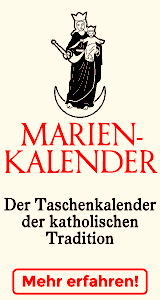 |
Loginoder neu registrieren? |
|||||
              
| ||||||
SucheSuchen Sie im kath.net Archiv in über 70000 Artikeln:     Top-15meist-diskutiert
|  Systematic liturgical rebellion against Rome in the Diocese of Linz10. Februar 2005 in English, keine Lesermeinung Official diocesan Website presents a "Liturgical Marketplace" with models for "women´s sermons", clearly positioning itself against the Church´s liturgical norms - alternative Lectionary with "Women´s Bible Readings" already being used in 20 parish Austria (www.kath.net) A special cause for concern can be found in the category "Models for Women´s Sermons". In a "Sermon Help Notes" (issue 33/2004) lay Pastoral Assistant Alexandra Freinthaler writes: "God is mankind´s good shepherdess, her wisdom is larger than this world´s, nobody can take from her those whom she has adopted in love. God and me, we are one, in our love, in our devotion to love every person in this world. We are fire and flame for mankind, we follow and protect them on all their ways - be they straight or not". In the "Final Prayer" Ms Freinthaler writes: "May the Holy Spirit (using here an artificial German word denoting the feminine form for Spirit - "Heilige Geistin", the translator), the one that wakes you up in the morning with a kiss and stands by you, through all your ups and downs, bless you" The divine Ruakh... Lay Pastoral Assistant Claudia Zethofer opened First Sunday of Lent´s Mass in 2002 with this "Prayer": "We begin this service in the name of the divine Power who created all Beauty in this world. In the name of Jesus Christ who opened our eyes to the love that is in us and around us. In the name of the Holy Spirit - of the divine Ruakh. She unites us and keeps us together." Gender-inclusive language and liturgical vestments The pages with the "Women´s Sermons Notes" are managed by a committee called "Liturgical Reform from Women´s Perspective". This group is composed by members of the Diocesan Women´s Commission and offers workshops with titles such as "On Sisters, Female Disciples & The Like". Their goal is achieving "a gender-inclusive language in Liturgy" and "granting woman an appropriate place in the services (according to their role, including liturgical vestments)". Ultimate goal: Equality of rights for women in Church Behind these liturgical experiments is the official diocesan Women´s Commission and its stated goal of "making again women visible in Church ". Such projects bring this goal´s accomplishment nearer by reaching a factual equality of "rights" for women in the Church. The Commission´s Website states: "This institutional basis means a special challenge for the Church Hierarchy and the Women´s Commission because it expresses the wish for structural changes and ultimately the factual equality of men and women in the Church". The website goes further: "We should not make the mistake of taking some positive changes, such as the creation of a Women´s Commission and the existence of an official Woman´s Representative in the Diocese, as a sign that structural injustices relating to gender issues have been solved". As examples of this "injustice" the site mentions the exclusion of women from the offices of Deacon and Priest and the fact that conclusions taken from Feminist Theology are classified as irrelevant. The Vatican: Sermons are a prerogative of Priests and Deacons" The Instruction "Redemptionis Sacramentum", issued by the Vatican in Spring 2004 has clear words for these liturgical experiments. A sermon made by a layperson is not accepted: "As was already noted above, the homily on account of its importance and its nature is reserved to the Priest or Deacon during Mass" (161) Believers have the right of a proper Church-approved Liturgy Cardinal Schönborn, who is also Austrian Bishop´s Conference President, stressed that believers have the right "of a proper liturgy celebrated according to the Church norms and not to services based on subjective feelings". The instruction has a legal character, says Cardinal Schönborn, and this character can be felt in the language it uses. "You read often about "abuses that must be stopped". Translation by Jose Martins KATH.NET, the Catholic NewsAgency for the german-speaking countrys, needs Your financial Help - Please send Your donation via PAYPAL to [email protected] - Many thanks in advance Big discussion in the KATH.NET-Forum (german language) Foto: (c) KATH.NET-Archiv; Liturgical abuse in a Parish of Wels (St. Franziskus) Ihnen hat der Artikel gefallen? Bitte helfen Sie kath.net und spenden Sie jetzt via Überweisung oder Kreditkarte/Paypal!  LesermeinungenUm selbst Kommentare verfassen zu können müssen Sie sich bitte einloggen. Für die Kommentiermöglichkeit von kath.net-Artikeln müssen Sie sich bei kathLogin registrieren. Die Kommentare werden von Moderatoren stichprobenartig überprüft und freigeschaltet. Ein Anrecht auf Freischaltung besteht nicht. Ein Kommentar ist auf 1000 Zeichen beschränkt. Die Kommentare geben nicht notwendigerweise die Meinung der Redaktion wieder. |  Mehr zuEnglish
|       Top-15meist-gelesen
| |||
 | ||||||
© 2026 kath.net | Impressum | Datenschutz | ||||||
